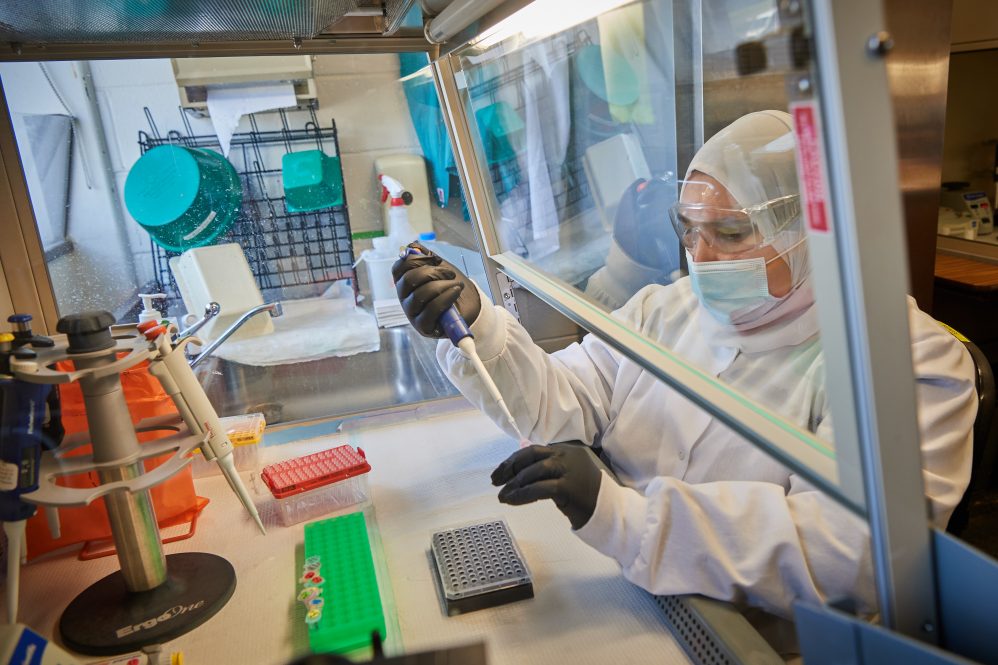Since the start of the pandemic, over 100 domestic dogs and cats have tested positive for SARS-CoV-2 in the United States. The first reported detection of the virus in a dog in Connecticut has been confirmed by Connecticut Veterinary Medical Diagnostic Laboratory (CVMDL) diagnosticians as a result of their surveillance for SARS-CoV-2 in dogs and cats. The findings are documented in a pre-print article* published earlier this month.
The report details findings from a postmortem examination of a three-month-old dog that died suddenly and was brought to the CVMDL for necropsy. Associate Director of the CVMDL and Department of Pathobiology and Veterinary Science Professor Guillermo Risatti explains that for the past year, the CVMDL has been working along with other veterinary diagnostic laboratories across the nation performing surveillance testing of all dogs and cats brought into the laboratory regardless of suspected cause of death.
Guidelines regarding COVID-19 and animals have been developed by the CDC. The virus is capable of being transmitted from people to animals in some circumstances. Surveillance and research continue in order to determine which animals are susceptible to infection and the risks of animals transmitting the virus to people, which is considered low given the current understanding of the virus.
The CVMDL is one of 38 laboratories across the country that are members of the National Animal Health Laboratory Network (NAHLN) and serve as part of a national surveillance program for SARS-CoV-2 in animals, says Director of the CVMDL and PVS Professor Salvatore Frasca.
The dog did not have signs compatible with COVID-19 prior to death. As part of the CVMDL’s ongoing surveillance for SARS-CoV-2, it was tested and would be the first positive SARS CoV-2 result reported by the CVMDL.
Assistant Professor Dong-Hun Lee heads the Genomics and Molecular Epidemiology Research (GaMER) lab in the Department of Pathobiology and has been working closely with the CVMDL to modernize and improve the quality and speed of infectious disease detection, monitoring, and investigation.
The genome of the virus was sequenced at the Lee lab, and it matched coronaviruses circulating in the human population over the winter of 2020-2021; however, it differed from other samples previously found in companion animals in the United States, and is not related to B.1.1.7 (UK), B.1.351 (South Africa), or P.1 (Brazil/Japan) variants, says Lee.
“The rapid detection and analysis of emerging infectious disease can deliver effective and timely response to public health emergencies,” says Lee. “My lab receives samples from the CVMDL, and my lab has a genome sequencing/bioinformatics pipeline that can rapidly diagnosis and characterize any pathogen in the clinical setting, in a clinically relevant timeframe.”
Lee points out the necessity for surveillance and notably, the need for more, “As of March 15th, only 6,723 animal tests have been reported to USDA. This is a really small number considering this is national data. Our data highlights that enhanced surveillance is needed and that we need more surveillance in animals since so much remains uncertain.”
The CVMDL has tested close to 200 samples, says Risatti, one positive test out of that relatively small number is a concerning statistic. The case is also paving the way for further research.
“There are still so many questions and we don’t have the complete picture yet.”
Surveillance leads to data, as Frasca points out, and the case detailed in the report is a perfect example, as the results were immediately turned into diagnostic research.
“The CVMDL is a diagnostic laboratory, but it is also an engine for research,” Frasca says.
The whole process is a collaboration and powerful teaching opportunity, from assay development, to sample collection and processing, to running the tests, to sequencing the virus.
Lee says, “We sequenced and analyzed the sample in the three working days and shared the data. As soon as the data was public, I gave it to the students in my bioinformatics class (PVS 4000). My students can assemble the sequence and can perform lineage assignment and phylogenetic analysis. I’m very proud they are able to use this data, it is a real-world example in real time.”
The diagnosis shows the importance of continued research into the virus, Frasca adds: “What is important to remember here is that everyone is still learning about the virus.”
For further information on the current state of knowledge about COVID in companion animals, visit the CDC, this CDC One Health presentation, and the USDA.
*Preprint articles are those awaiting peer review.



